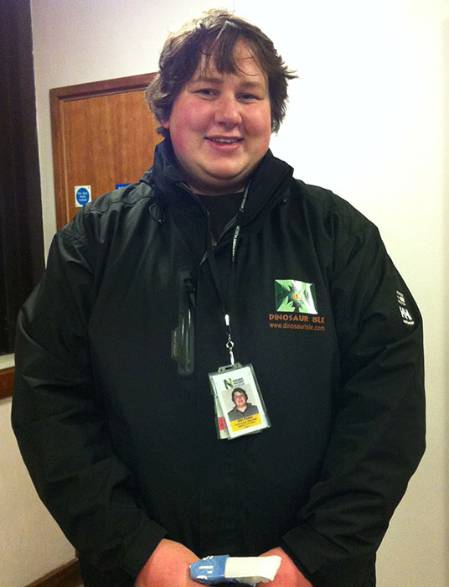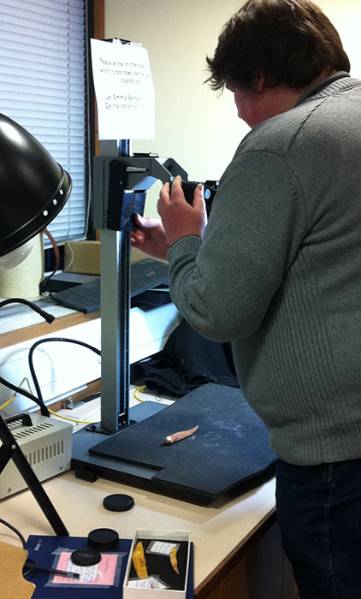As part of my job I often work with other curators and museum professionals. Part of having such a good network of colleagues is that we can learn from each other (us 'experts' don't know everything!).
Back in January (27th - 31st), I had the pleasure of the assistance of Alex Peaker who is a palaeontologist at Dinosaur Isle Museum on the Isle of Wight. Alex wanted to come to the Palaeontology Section to see how we document our specimens and deal with research visitors.
Here Alex tells us a bit about his job at Dinosaur Isle Museum and what he got up to during the week...
 Alex Peaker ready to start his week with us at the Natural History Museum.
Alex Peaker ready to start his week with us at the Natural History Museum.
Dinosaur Isle is a museum that promotes the wealth of geology and palaeontology that can be found on the Isle of Wight. It displays a particularly fantastic collection of local dinosaur finds.
In a normal day's work I mostly deal with curation of the collection, spending much of my time documenting specimens into our electronic database, working with associated documentation, assisting with any enquiries, and facilitating research on our specimens.
Last year I had the fantastic opportunity to work for the museum with the Isle of Wight Destination Management Organisation, BBC, and 20th Century Fox, teaming together to work on promotion for the recently-released film Walking with Dinosaurs - the 3d movie. The result saw the creation of the Dinosaur Island augmented reality app, which has been a fantastic success in promoting the movie, the island, and our dinosaurs.
Recently I was given the chance to spend a week working at the Natural History Museum, which was greatly appreciated; the time that I spent there was absolutely amazing. The reason for the trip was to further my ability in curation, to work with people who have a wealth of experience in the area and to see how our practices compare to that of a national museum.
I spent the week working with Emma Bernard in the Fossil Fish Section, looking at:
- documentation procedure
- digitisation of the collection onto the Museum database (KE EMu)
- general museum standards and policies
- interpretation and outreach
- display and storage of specimens
It was great to be able to work with such an amazing collection, and often with fossils that I have only seen in books. Virtually every drawer I opened seemed to have either a type fossil (the single specimen designated by an author to formally describe a new species), or something with an interesting history (e.g. donated by Sir Richard Owen). My personal favourites were a large Brychaetus (prehistoric bony fish) skull from the Isle of Sheppey, and a particularly large megalodon tooth (everybody loves a big shark, but even for megalodon this one was a real beast).
Large Brychaetus skull (NHMUK PV P 3893), found from the Isle of Sheppey, UK.
Megalodon tooth (NHMUK PV P 14534), found in Virgina, USA.
I was also given a chance to visit the Cephalopod and Brachiopod Section with Zoe Hughes, which was very interesting. I was shown some fantastic fossils including an amazing squid showing preservation of all of its soft tissue, and was even privileged enough to have a viewing of the 'Royal Brachiopod' (a fossil collected by Darwin on the Falklands that is often used as an example to royal visitors).
Thankfully the procedures set up at the Museum are very similar to those that I would work by at Dinosaur Isle but with some differences, most of which seem to derive from the size of the collections and slightly different collection policies (apart from a few comparative pieces, our collection holds exclusively Isle of Wight fossils whereas the Museum collects specimens from all over the world).
I learnt a lot in a week at the Museum with much of my newly-gained experience already having been a help at Dinosaur Isle. It was great to work with a fantastic group of people who were incredibly helpful and showed me a lot of great things.
I would like to thank the South East Museum Development Programme for the funding and making this opportunity possible.
Alex photographing shark fin spines we brought back from Morocco.
Thanks very much to Alex for all his help during the week. He helped to document a lot of the specimens we collected whilst in Morocco and locate several specimens connected with our upcoming Sir Arthur Smith Woodward Symposium. I also learnt from Alex by discussing how he carries tasks out at Dinosaur Isle.



.jpg)

